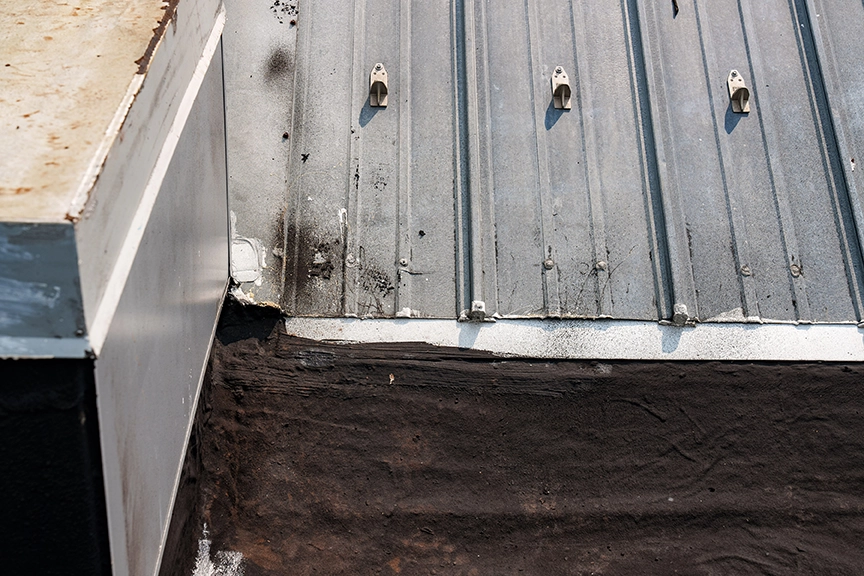Prevent Wind Uplift Damage with Routine Inspections
A cool, gentle breeze on a warm day is refreshing. But a formidable wind gust from a storm or as the result of a strong low-pressure system—if it’s a hurricane, tornado, or thunderstorm—can cause damage to any freestanding structure. In the Northeastern United States, high winds are typically most prevalent between the season changes—fall to winter and winter to spring—as weather patterns shift.

When it comes to commercial roofing systems, there is one specific type of damage that occurs due to the wind known as “Wind Uplift.” This happens when the pressure difference created by wind flow over a roof causes the roofing material to lift or separate from the roof deck or supporting structure. Wind uplift is a force measured in pounds per square foot and is intensified during high wind events when air infiltrates a building and causes an increase in air pressure below the roof, while the speed of the wind over the roof reduces the air pressure above it.
Wind uplift is especially prevalent at the edges and corners of a roofing system because these areas are subject to a higher magnitude of pressure. Wind uplift can cause damage to a variety of commercial building roof types including single-ply roofs, spray foam, metal roof coating, and shingle roofing.
Loosening of Fasteners
Wind uplift can loosen fasteners, such as nails or screws, that hold roofing materials in place. Once the fasteners are compromised, the roofing materials become more vulnerable to being lifted by the wind, which will eventually result in a compromised roof system.
Lifting and Peeling
Strong winds create an upward force on a roof’s surface. If roofing materials are not adequately secured or if the components are old or damaged, the wind can lift and peel them away from the roof deck. In addition to blowing roofing material away, lifting and peeling can also expose the underlying roof structure, which can result in additional destruction.
Roof Material Damage
In a severe storm, shingles, tiles, flashing, or other roofing materials can be torn off or broken by the force of the wind. This type of damage can compromise the integrity of the roof and lead to leaks and further deterioration over time if not repaired. Roofing material can also balloon, which is another sign of damage.
Water Intrusion
As roofing materials are lifted or damaged by wind uplift, gaps and openings can form, allowing water to infiltrate the roof system. Roof leak repair, water damage to the interior of the building, and potential mold growth are all significant problems that can result if these issues are not addressed properly.
Roof Deck Detachment
When wind uplift is greater than what the building system was designed for, the roof deck can detach from the supporting structure. This is most likely to occur if the roof deck has open joints.
Structural Damage
In severe cases, wind uplift can cause structural damage to a roof deck. This can include the bending or buckling of the roof frame, weakening of the trusses or rafters, or even the partial or complete collapse of the roof structure.
To prevent wind uplift damage from occurring on commercial roofing systems, facility managers should have a commercial roof maintenance plan. By conducting regular commercial roof inspections, a maintenance plan will ensure all roofing assets are in good condition and allow for the repair of minor issues before they become a roofing emergency.
A roof maintenance plan will also ensure a roof is properly designed, constructed, and maintained to withstand expected wind loads. The wind load calculation for a commercial roof will vary, depending upon which part of the country the facility is located, and building codes will mandate specific wind-resistant roofing requirements. A trained roofing technician can also recommend wind-resistant roofing materials and adequate fasteners to ensure the roofing system remains intact.
A standard roof maintenance plan should include inspection of the following roofing components to determine if there is any wind uplift damage.
- Rivets, bolts, or fasteners that are loose
- Flashing that is removed or loosened from the roof perimeter
- Membrane or ballast that is removed or lifted and dropped back into place
- Insulation that is displaced
- Deck panels that are dislodged or delaminated
- Roof surface damage
- Skylights, vent grates, or vent pipes that are dislodged
A commercial roof maintenance plan will prevent potential wind uplift damage and ensure your commercial roof is performing at its optimal capacity. If you don’t have a roof care maintenance plan, contact Capital Roof Care. Our skilled roof technicians will identify signs of damage that require immediate or future repairs or that call for restoration or replacement solutions.
Sources:
How Wind Uplift Can Affect a Commercial Building’s Roof